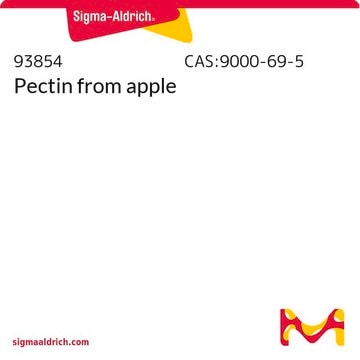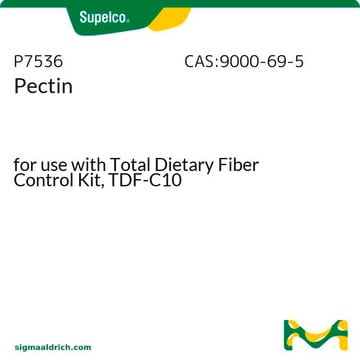P3889
Polygalacturonic acid
≥85% (titration), from oranges
About This Item
Recommended Products
biological source
oranges
Assay
≥85% (titration)
form
powder
color
white to brown
mp
60 °C
solubility
aqueous NaOH: 1%, clear to hazy
storage temp.
room temp
InChI
1S/C6H10O7/c7-1-2(8)4(5(10)11)13-6(12)3(1)9/h1-4,6-9,12H,(H,10,11)/t1-,2+,3+,4-,6-/m0/s1
InChI key
AEMOLEFTQBMNLQ-BKBMJHBISA-N
Looking for similar products? Visit Product Comparison Guide
General description
Application
- in the preabsorption of 2F4 primary antibody solution
- as a substrate to determine polygalacturonase activity
- in the preparation of oligogalacturonates mixture which is used as a substrate to determine the specificities of different acetylesterases
Biochem/physiol Actions
Other Notes
Storage Class Code
11 - Combustible Solids
WGK
WGK 3
Flash Point(F)
Not applicable
Flash Point(C)
Not applicable
Personal Protective Equipment
Certificates of Analysis (COA)
Search for Certificates of Analysis (COA) by entering the products Lot/Batch Number. Lot and Batch Numbers can be found on a product’s label following the words ‘Lot’ or ‘Batch’.
Already Own This Product?
Find documentation for the products that you have recently purchased in the Document Library.
Customers Also Viewed
Protocols
To measure pectinase activity, a titrimetric stop reaction assay is used. One unit of pectinase will liberate 1 μmol of galacturonic acid from poly-galacturonic acid per hour at pH 4.0 at 25 °C.
Our team of scientists has experience in all areas of research including Life Science, Material Science, Chemical Synthesis, Chromatography, Analytical and many others.
Contact Technical Service








